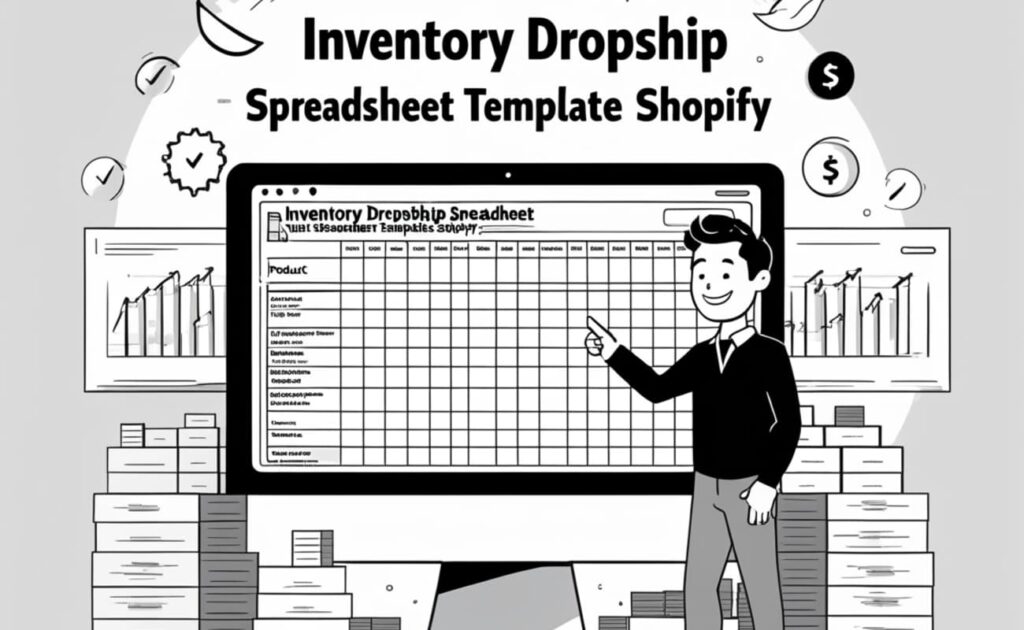Welcome to our comprehensive guide on the inventory dropship spreadsheet template Shopify solution that can revolutionize your dropshipping business. If you are serious about managing inventory efficiently while juggling multiple suppliers and predicting demand accurately, you’re in the right place. Before we dive in, feel free to explore our homepage for more insightful articles. This post also sheds light on common challenges and practical, table-based solutions that streamline operations, ultimately saving time and money.
Understanding the Dropshipping Inventory Challenge
Running a dropshipping store on Shopify can feel like walking a tightrope—especially when it comes to ensuring you have the right stock levels across numerous suppliers and platforms. One of the biggest challenges is synchronizing inventory data from multiple sources while predicting demand fluctuations accurately. Mismanagement of inventory can lead to overselling, stockouts, or even dissatisfied customers. This is where a robust inventory dropship spreadsheet template Shopify becomes vital.
Common Pain Points in Dropshipping Operations
Have you ever wondered how top dropshippers keep their inventory management error-free? The answer often lies in the effective use of technology and an inventory dropship spreadsheet template Shopify. Some recurring issues include:
– Coordinating inventory from various suppliers
– Forecasting demand during peak sales periods
– Updating product details in real time
Such challenges can be addressed using a well-designed inventory dropship spreadsheet template Shopify that integrates seamlessly with your Shopify dashboard.
The Power of a Table-Driven Inventory Management Approach
The beauty of using an inventory dropship spreadsheet template Shopify is its simplicity combined with powerful functionalities. With a dedicated inventory dropship spreadsheet template Shopify, you can track everything from stock levels to shipping costs, and even get alerts when it’s time to reorder. Instead of manually combing through tons of data, why not have it all structured in easy-to-read tables? These tables not only enhance readability but also help in spotting trends and irregularities quickly.
Structuring Your Inventory Template
Imagine having an all-in-one dashboard that displays product names, supplier details, inventory levels, reorder points, and even calculated margins. A spreadsheet structured this way—especially when using an inventory dropship spreadsheet template Shopify—enables you to make informed decisions faster. Here’s a sample table that outlines the essential elements of a robust Shopify inventory dropship spreadsheet template:
| Product ID | Product Name | Supplier | Current Inventory | Reorder Point | Shipping Cost | Calculated Profit |
|---|---|---|---|---|---|---|
| P001 | Wireless Earbuds | Supplier A | 50 | 20 | $5 | $15 |
| P002 | Smart Watch | Supplier B | 30 | 10 | $8 | $22 |
| P003 | Bluetooth Speaker | Supplier C | 70 | 30 | $4 | $18 |

Features of the Ultimate Shopify Inventory Template
This ultimate inventory dropship spreadsheet template Shopify is more than just a simple inventory list. It is loaded with functionalities that address core challenges in dropshipping:
Automatic Inventory Tracking and Critical Level Alerts: Gone are the days of manually scanning spreadsheets to check stock. With the inventory dropship spreadsheet template Shopify, built-in formulas and conditional formatting allow you to automatically track current inventory levels and even set up alerts when stocks dip below predefined thresholds.
Profit Calculation Considering Shipping Costs: A conventional profit calculator may overlook shipping fees, which are crucial in the dropshipping model. The inventory dropship spreadsheet template Shopify integrates shipping costs into the equation, ensuring you have a clearer picture of your margins.
Seamless Integration with Inventory Management Apps: The inventory dropship spreadsheet template Shopify is designed to harmonize with popular apps such as Inventory Planner, allowing for real-time data updates and smoother operations.
Using Formulas and Conditional Formatting to Enhance Functionality
What sets the inventory dropship spreadsheet template Shopify apart is its intelligent use of formulas. For instance, automated calculations determine the profit margin by considering product cost, shipping expenses, and selling price. Additionally, the inventory dropship spreadsheet template Shopify uses conditional formatting to highlight critical inventory levels using color codes, ensuring that you never miss a restock signal. This level of automation within the inventory dropship spreadsheet template Shopify not only reduces human error but also saves you valuable time.
Implementing the Spreadsheet Template in Your Workflow
Transitioning to a table-driven strategy may sound daunting at first, but once you see the benefits of using an inventory dropship spreadsheet template Shopify, you’ll realize how indispensable it is. Start by downloading a free inventory dropship spreadsheet template Shopify, which often comes as a Google Sheets template pre-loaded with essential formulas. Once you have set it up, customize the columns in your inventory dropship spreadsheet template Shopify to fit your business model and sales channels.
One of our users recently shared, “Integrating this inventory dropship spreadsheet template Shopify into our existing system reduced our stock discrepancies by over 40%. It was a game-changer!” This type of feedback is what fuels the continuous improvement of inventory dropship spreadsheet template Shopify practices in the e-commerce space.
Integrating with Shopify and Other Apps
The inventory dropship spreadsheet template Shopify doesn’t operate in isolation. In fact, its real strength lies in its compatibility with Shopify and companion apps like Inventory Planner. Have you ever wondered how to achieve a seamless data flow between your inventory dropship spreadsheet template Shopify and your e-commerce platform? The answer is synchronization. With APIs and periodic imports, the inventory dropship spreadsheet template Shopify can be a live reflection of your online store’s inventory status. This integration minimizes manual inputs and errors, creating a more efficient ecosystem for your dropshipping operations.
Evaluating the Benefits: A Data-Driven Approach
Data is the backbone of any successful dropshipping business. Regular monitoring of inventory levels, combined with automated alerts, empowers you to make proactive decisions. The template can help you identify patterns in product sales, anticipate seasonal demand, and adjust purchase orders accordingly. Simply put, it offers a holistic view of your business by combining real-time inventory tracking with historical data analysis.
You might ask, “How reliable can a spreadsheet be?” The answer lies in its customizability. With the right formulas and data validation, the inventory dropship spreadsheet template for Shopify ensures that you have an accurate and reliable overview of your operations. It transforms a complex set of data into actionable insights that can significantly impact profitability.
Customizable Views for Better Data Clarity
For a more organized look, consider creating multiple sheets within your workbook—one for daily inventory tracking, another for historical sales, and a third for forecasting and financial analysis. For example, you could have a summary table on one sheet that provides at-a-glance insights into which products are nearing their reorder thresholds, while another sheet might offer detailed listings for each supplier. This multi-tab approach prevents information overload while keeping critical data at your fingertips.

Free Resources and Critical Error Warnings
At no cost, you can access Google Sheets templates that are pre-equipped with many of these features. These free inventory management tools are an excellent starting point for small businesses looking to upgrade their tracking systems without incurring additional expenses. However, it’s important to note that manual data entry has its pitfalls. Common errors include misalignment of columns, incorrect formula inputs, and data duplication. To help you avoid these, our guides also include error-checking protocols to ensure that your data remains accurate.
Moreover, ensuring that your spreadsheet data is regularly backed up can protect you against data corruption or accidental deletion. After all, having a reliable backup is as critical as the template itself.
Table: Common Errors and Their Solutions
| Error | Description | Solution |
|---|---|---|
| Data Mismatch | Incorrect entries due to manual imports | Use data validation and auto-import features |
| Formula Errors | Improper calculations due to misapplied formulas | Double-check cell references and test formulas |
| Outdated Data | Inventory levels not updated in real time | Integrate with Shopify API or inventory apps |
Real-Life Experience and Tips for Success
Let me ask you this—have you ever felt overwhelmed by the constant influx of data and the pressure to keep everything updated? I certainly have. In my early days of managing a Shopify store, the chaos of manual tracking was daunting. Transitioning to an automated, table-driven method using the ultimate Shopify inventory template was a turning point. The ability to instantly capture renovations in inventory levels, adjust for seasonal trends, and maintain a cohesive view of business performance transformed my approach significantly. This template not only streamlined my workflow but also provided clarity during peak sales periods, reducing operational stresses dramatically.
In moments where you feel swamped by the complexity of multiple suppliers, remember the benefits of this system. By trusting a spreadsheet solution, you minimize errors and enhance your decision-making process with actionable insights. Have you tried simplifying your inventory management with a digital template yet?
Integrations with Third-Party Tools
A key advantage of the Shopify dropshipping inventory template is its ability to integrate with third-party tools. Whether it’s syncing with Inventory Planner or using APIs to automatically update your stock levels, these integrations extend the capabilities of your simple spreadsheet far beyond manual calculations. Many leading e-commerce experts recommend these practices to improve both accuracy and efficiency.
For further reading on seamless integrations and advanced inventory management techniques, check out this reputable resource from Shopify’s official blog. The in-depth articles there illustrate how automation and smart tools can drive your business towards long-term success.
Conclusion: Streamline Your Shopify Dropshipping Today
In conclusion, the inventory dropship spreadsheet template for Shopify is not just a tool—it’s an investment in efficiency. By addressing the core challenges of inventory management, offering robust integration capabilities, and providing real-time alerts on critical stock levels, this solution empowers you to run your dropshipping business more smoothly. With features like automatic tracking, comprehensive profit calculations, and user-friendly tables, the template transforms complex data into clear, actionable insights.
If you’re ready to upgrade your Shopify store’s inventory management, now is the time to dive in. And if you’re curious about how these improvements might affect your overall business performance, take a moment to read our detailed article on dropshipping salary. This additional resource provides further insight into the advantages of a streamlined approach.
FAQ
Q1: What is a free dropship inventory tracker for Shopify?
A: It is a free, pre-designed spreadsheet template—often available as a Google Sheets file—that allows you to track stock levels, supplier details, shipping costs, and profit margins in a simple, organized manner. These trackers can be customized to meet your specific needs for Shopify dropshipping.
Q2: How can a Shopify dropshipping inventory template benefit my business?
A: A well-designed spreadsheet template simplifies inventory management by automatically updating stock levels, calculating profits considering shipping fees, and alerting you when it’s time to reorder items. This reduces errors, saves time, and improves overall operational efficiency.
Q3: Can this template be integrated with other inventory management apps?
A: Absolutely. One of the strengths of this template is its seamless integration with popular apps like Inventory Planner. This ensures real-time data synchronization between your Shopify store and the spreadsheet, streamlining your workflow significantly.
Q4: What are the common errors in manual data entry?
A: Manual entry often leads to data mismatches, formula errors, and outdated inventory numbers. Our template mitigates these issues through automated calculations, built-in validation, and error-checking protocols, providing a more reliable system.
Q5: Where can I find additional resources for managing dropshipping inventory?
A: In addition to free Google Sheets templates, you can visit trusted sources like the Shopify blog for expert tips and advanced strategies on inventory management and dropshipping success.
